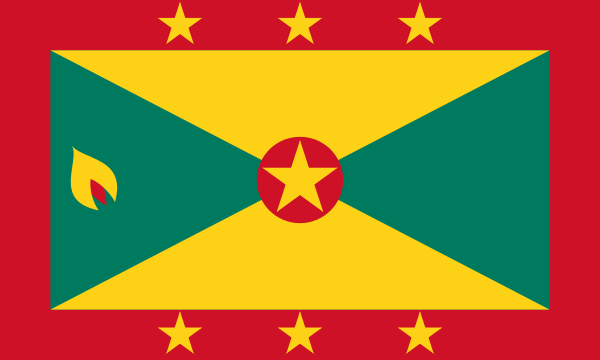1. Colors:
Red: The flag's profound red hue serves as a dynamic canvas, artfully portraying the unwavering spirit of the Grenadian people. This deep crimson symbolizes a lineage of courage, determination, and ancestral sacrifices etched into the annals of history. Within its pigment are narratives of trials and tribulations, interwoven with the resilience required to surmount adversities. In the crimson tones, one finds an ode to the collective unity and robust strength that courses through the veins of the nation.
Yellow: Adorning the pinnacle and nadir of the flag are slender bands of yellow, evoking the radiant embrace of Grenada's sun-kissed terrain. This golden hue encapsulates the island's tropical embrace, a sun-drenched promise of a luminous future. Within its golden embrace resides a wellspring of hope, a beacon of optimism that heralds boundless growth, prosperity, and the unfolding of vibrant potentials.
Green: Nestled resplendently within the upper left corner, the green isosceles triangle is an embodiment of Grenada's fertile landscapes, a verdant tableau that reverberates with the echoes of lush forests and fertile fields. Its hue is an homage to the island's agricultural heritage, a testament to a history intertwined with the cultivation of nutmeg, cocoa, and bananas. This verdure is emblematic of Grenada's solemn commitment to environmental stewardship, resonating with the symphony of leaves, branches, and crops that thrive under its nurturing gaze.
2. Green Triangle:
vShape and Positioning: The green triangle, an isosceles marvel, graces the flag's upper left quadrant with dynamic flourish. Its diagonal trajectory converges towards the heart of the design, an enchanting dance that captivates the eye and imparts a sense of fluid movement. This positioning is a visual ode to the nation's journey, an invitation to trace the path from the past to a future yet unfurled.
Symbolism: This verdant triangle is not a mere geometrical arrangement; it is a potent symbol imbued with profound meanings. Within its angles lies a tapestry of history, telling tales of Grenada's fertile soils, the yield of bounteous vegetation, and the labors of an agrarian past. It pays homage to a legacy shaped by crops like nutmeg, cocoa, and bananas, a reminder of the island's economic sustenance, and an enduring tie to the land that nourishes its people.
3. Overall Design and Composition:
Geographical Reflections: The flag is a triptych of colors, each mirroring the geographic tapestry of Grenada itself. The red embodies the restless waves of the surrounding Caribbean Sea, its rhythm echoing the tides that cradle the island. The yellow captures the sandy embrace of Grenada's shores, a tribute to its coastal identity. Lastly, the green resonates with the emerald majesty of the island's interior, the undulating hills and soaring mountains that embrace the heartland.
4. Historical Context:
Epochal Transition: The flag's formal adoption on February 7, 1974, stands as an indelible testament to Grenada's metamorphosis from a colonial outpost to an independent nation. A tangible break from the vestiges of colonialism, the flag became a canvas upon which the aspirations, dreams, and indomitable spirit of a people found vivid expression.
Embodying Aspirations: The flag's design encapsulates Grenada's historic trajectory, weaving together threads of a nation's evolution. Its composition embodies the aspirations of a populace determined to steer its own destiny, unfurling an emblematic testament to self-governance, identity, and autonomy.
5. National Identity and Pride:
Symbolic Anthem: The flag unfurls as a resonant anthem of Grenadian identity and pride, an emblematic embodiment of the spirit that courses through the nation's veins. It takes center stage during national observances, a visual hymn that binds citizens in a shared embrace of purpose and belonging.
Cultural Adornment: The flag is a symbol of Grenada's cultural heritage, a vivid portrayal of the nation's intrinsic allure and the resolve of its inhabitants. It stands as an unwavering testament to the collective commitment to shape the course of destiny, an embodiment of the harmonious blend of history, nature, and ambition.
In sum, the Grenada flag is a masterful tapestry woven from history, geography, and the kaleidoscope of emotions that define a nation. It captures the essence of Grenada's evolution, a vibrant emblem that narrates tales of independence, progress, and the harmonious communion between the land and its people.
Last Updated on: July 09, 2025
